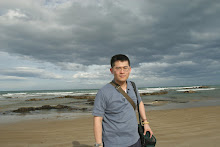I haven’t visited this place for some time, and yet Flinders Blowhole at Cape Schanck greets me as though no days have passed. The rugged coastline stretches in quiet defiance against the ceaseless surge of the Southern Ocean, and in the distance, a solitary, large rock rises like a sentinel over the restless waters. Each wave that rushes forward tumbles over its surface, forming a miniature waterfall that never ceases, a constant, shimmering cascade that mirrors the relentless heartbeat of the sea.
As the sun leans toward the horizon, the golden hour bathes everything in its tender, amber glow. The light catches each droplet, turning spray into scattered sparks, and sets the rock aglow with a warmth that belies the ocean’s chill. Shadows lengthen across the sand and jagged cliffs, and the sound of the surf—deep, rhythmic, and insistent—fills the air with a meditative cadence.
There is a quiet poetry in the way nature balances motion and stillness here: the steadfast rock, the ever-moving water, the sky’s fleeting palette of gold and rose. Each moment feels suspended, as if time itself slows to honor the simple, profound beauty of the scene. I linger, drawn by the hypnotic rhythm of waves and light, feeling both small and infinite in the embrace of Cape Schanck’s wild, luminous edge.
Sony A7RV
FE 20-70mm f4 G
Linking Treasure Tuesday





















